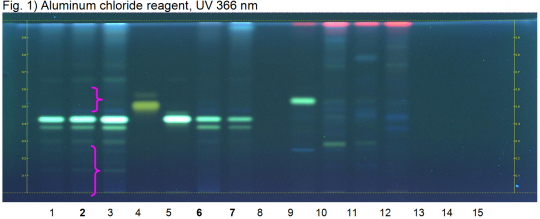Drynaria fortunei (rhizome)
Contents |
Nomenclature
Drynaria fortunei (Kunze ex Mett.) J. Sm. Polypodiaceae
Standardized common name (English): drynaria
Pinyin name(s): hu jue; gu sui bu (rhizome)
Botanical Voucher Specimen
Organoleptic Characteristics
Macroscopic Characteristics
Microscopic Characteristics
High Performance Thin Layer Chromatographic Identification
|
Drynaria rhizome, gu sui bu (rhizome) (Drynaria fortunei) Lane Assignments Lanes, from left to right (Track, Volume, Sample):
Reference Sample(s) Reference: Dissolve 1 mg of hyperoside in 1 mL of methanol; Dissolve 1 mg of naringin in 1 mL of methanol. Stationary Phase Stationary phase, i.e. Silica gel 60, F254 Mobile Phase Ethyl acetate, acetic acid, formic acid, water 100:11:11:26 (v/v/v/v) Sample Preparation Method Sample: Mix 500 mg of powdered sample with 5 mL of methanol and sonicate for 10 minutes, then centrifuge or filter the solutions and use the supernatants / filtrates as test solutions. Derivatization reagent: Aluminum chloride reagent R, Preparation: Dissolve 4 g of aluminum chloride in 200 mL of a 5% solution (v/v) of glacial acetic acid in methanol, Use: dip (time 0, speed 5). Detection Method Saturated chamber; developing distance 70 mm from lower edge; relative humidity 33% Other Notes Images presented in this entry are examples and are not intended to be used as basis for setting specifications for quality control purposes. System suitability test: Hyperoside: yellow fluorescent zone at Rf ~ 0.50; Naringin: blue white fluorescent zone at Rf ~ 0.42. Identification: Compare result with reference images. The fingerprint of the test solution is similar to that of the corresponding botanical reference sample. Additional weak zones may be present. The chromatogram of the test solution shows an intense greenish blue white zone at Rf ~ 0.42 corresponding to reference substance naringin. Right below this zone there is a less intense greenish blue white zone at Rf ~ 0.38. Test for other species: No intense zone is seen between the application position and Rf ~ 0.30 (Humata tyermanni Moore, Drynaria bonii, Drynaria rigidula, Drynaria sparsisora) and no zone is seen at the position of reference substance hyperoside (Humata tyermanni Moore) (pink arrows).
|
Supplementary Information
Sources
- ↑ HPTLC Association http://www.hptlc-association.org/
